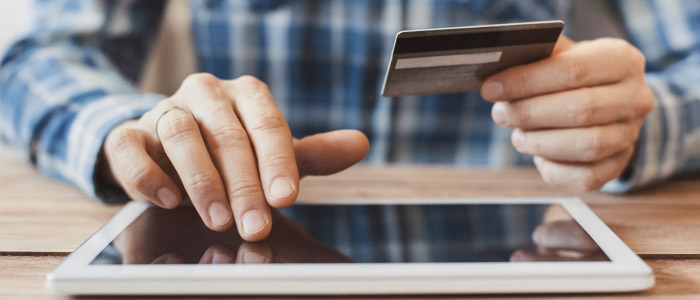
Online shopping has revolutionized the way we shop and spend money. It has become relatively simple to access all manner of goods and services, no matter where you live. People who live in small towns or rural areas are no longer limited by what’s available in their home towns. Now they can access the same things as people who live in large cities with physical shopping locations all around them. And it has also become easier to compare prices to get the best deals.
Even though online shopping has become a great tool, it does come with a potential downside. Unfortunately, online shopping has made it easier for fraudsters to steal personal identities or financial information. Consider these four tips for protecting yourself while shopping online:
Pay with VISA® to protect yourself and your accounts when shopping online.
- Use secure networks — If you’re relying on public WiFi, avoid shopping online or visiting any financial institutions altogether. Don’t access your bank accounts, credit card accounts, or anything you want to be kept private. Even your favorite café or local public library WiFi isn’t always a safe bet. It’s easier for potential hackers to break through public WiFi than on private, more secure systems. To be sure your connection is secure, rely on a Virtual Private Network (VPN).
- Stick to sites you know — Shop only on websites you know and trust to be legitimate. And if you’re new to the site, give it a quick review for potential warning signs. Are there misspellings? Does it appear to be professional? Double-check that the web address is correct. Especially watch out for incorrect domain codes. (A domain code is the suffix that follows a site’s name, for example, Amazon.net instead of the correct Amazon.com.) To be especially certain you’re at the right site, type in the address instead of clicking on links.
- Look for website security features — Is the site secure for making payments online? You can look for security features, like the way the web address begins. A website that begins with https:// is considered to be more secure than one that begins only with http://. You might also find a padlock symbol in the address bar to indicate that the site is secure. These features can help you ensure any payment information is encrypted before being sent across the Internet.
- Check your financial statements carefully — One of the easiest ways to spot a potential security compromise is by carefully checking your bank and credit card statements every month. If you find any suspicious transactions, investigate immediately. You also can get your credit report for free once a year from each of the three top credit reporting agencies. This is a good way to see if any new or unauthorized credit cards or accounts have been opened in your name without your knowledge. Another great way to stay on top of your accounts is to set up alerts so you are notified immediately about transactions that interest you.
Ultimately, shopping online is a great tool for saving time and money, but be diligent about protecting yourself.